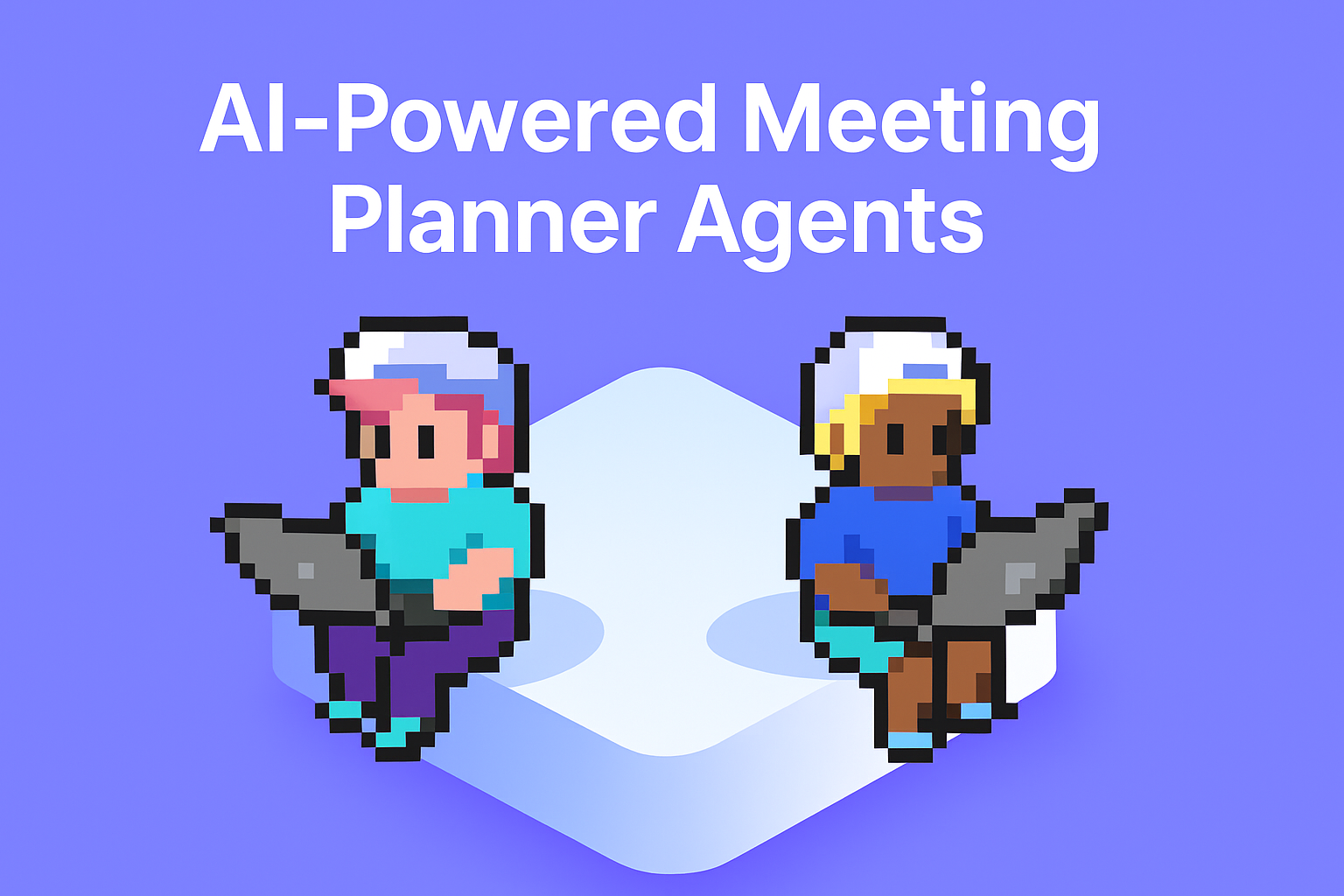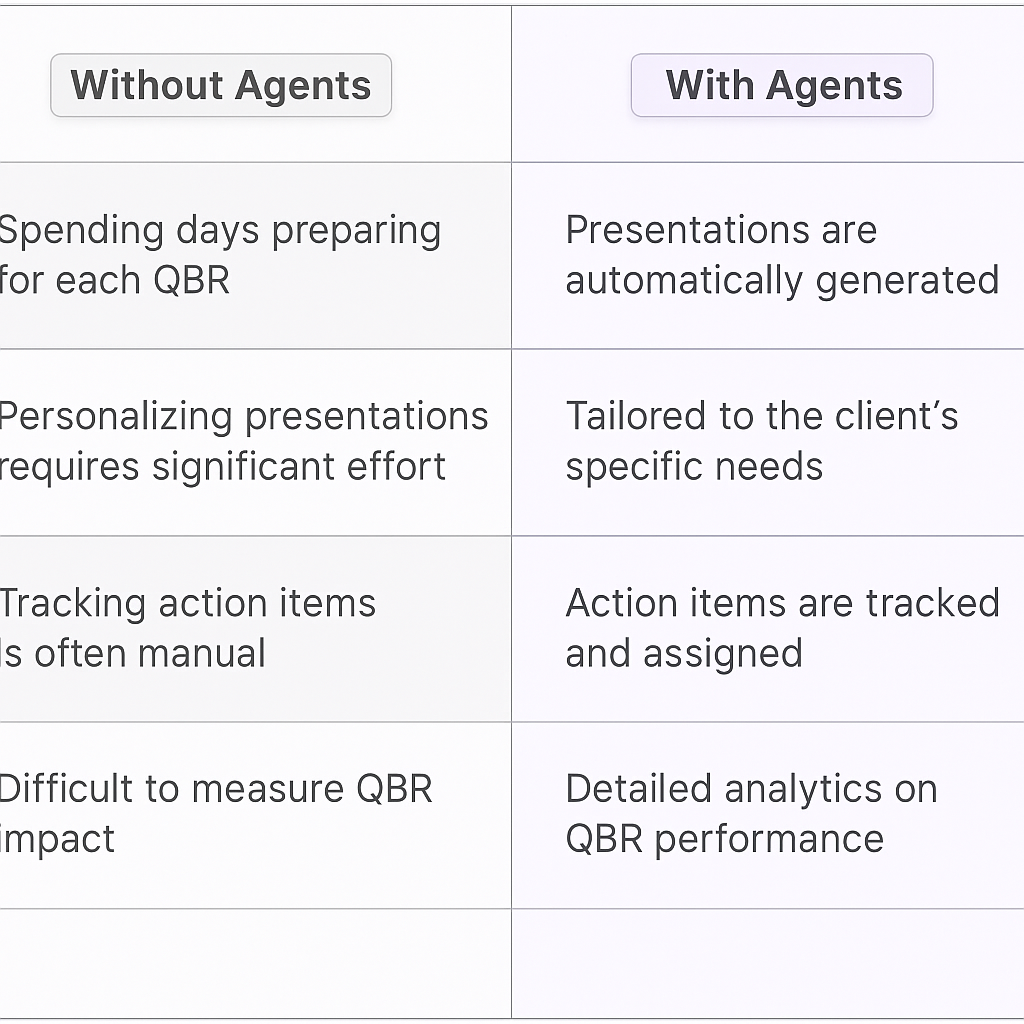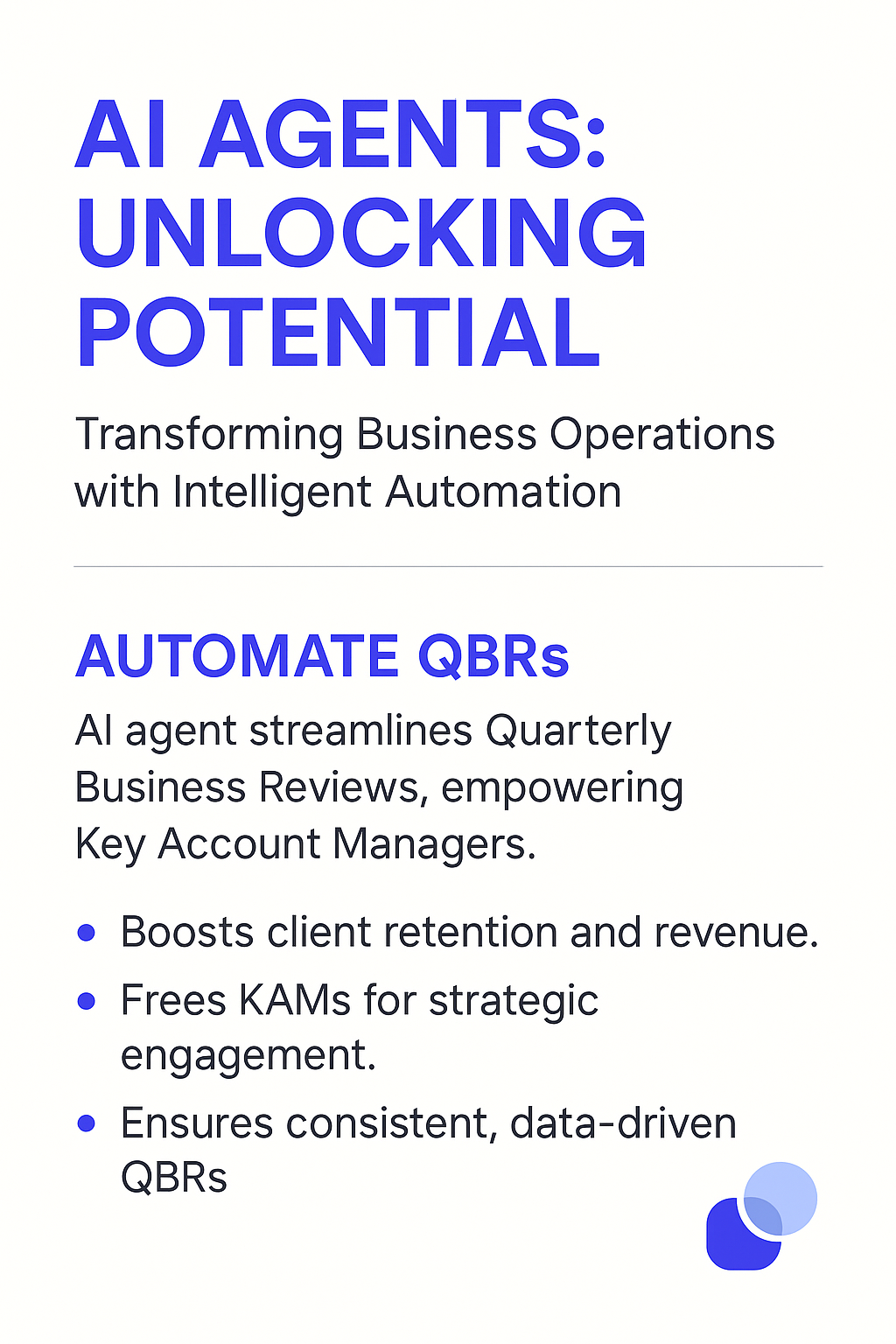
AI-powered meeting planner agents are revolutionizing how Key Account Managers conduct Quarterly Business Reviews (QBRs). These agents automate the preparation, execution, and follow-up of QBRs, allowing managers to focus on building relationships, delivering value, and identifying growth opportunities. This technology streamlines workflows, enhances client engagement, and drives better business outcomes.
Before Meeting
Your AI agent compiles performance data, identifies key trends, and generates a draft presentation highlighting achievements and areas for improvement. You walk into the meeting with a data-driven narrative ready to present.
During Meeting
As the discussion evolves, your AI agent tracks action items, captures client feedback, and adjusts the presentation in real-time to address specific concerns or opportunities. This keeps the meeting dynamic and responsive.
After Meeting
Post-meeting, your AI agent sends a summary of key takeaways, assigns action items to team members, and schedules follow-up meetings. This ensures accountability and keeps the momentum going.
What you’ll need
You don't need to be a developer to set up this integration. Follow this simple guide to get started:
- Meeting Notetaker Agent template
- Calendar account
- Meetings to join
- Relevance AI Account

Who this agent is for
This agent is designed for Key Account Managers, Client Success Managers, Sales Directors, and anyone responsible for conducting Quarterly Business Reviews (QBRs) with key clients. It's ideal for individuals and teams who need to prepare comprehensive reports, track performance metrics, and facilitate productive discussions with clients. Whether you're managing a portfolio of strategic accounts or leading a team of account managers, this agent simplifies the QBR process and ensures that every meeting is a success.
How this agent makes QBR planning easier
Automate data gathering and report generation
Instead of manually compiling data from various sources, the agent automatically gathers relevant performance metrics, client feedback, and market insights to generate a comprehensive QBR report. This saves significant time and ensures that the report is accurate and up-to-date.
Personalize presentations for each client
The agent tailors the QBR presentation to each client's specific needs and priorities, highlighting the value delivered, addressing any concerns, and identifying opportunities for growth. This ensures that the presentation is relevant and engaging for the client.
Track action items and follow-up tasks
The agent automatically track action items discussed during the QBR and assigns them to the appropriate team members. It also sends reminders and follow-up tasks to ensure that all action items are completed on time.
Facilitate productive discussions
The agent provides talking points, discussion prompts, and real-time feedback to help facilitate productive discussions during the QBR. This ensures that the meeting stays on track and that all key topics are addressed.
Benefits of AI Agents for Key Account Managers
What would have been used before AI Agents?
Key Account Managers traditionally relied on manual methods, such as spreadsheets, CRM reports, and email threads, to prepare for QBRs. This process was time-consuming, prone to errors, and often resulted in inconsistent reports. They would spend valuable time gathering data, creating presentations, and coordinating with internal teams, taking away from their core responsibilities of building relationships and driving revenue.
What are the benefits of AI Agents?
AI agents offer a streamlined and automated approach to QBR planning, freeing up Key Account Managers to focus on more strategic tasks. The most significant benefit is the time saved by automating the data gathering and report generation process. The agent handles everything from compiling performance metrics to creating visually appealing presentations, reducing the administrative burden on the manager.
AI agents also ensure that QBRs are personalized and relevant to each client. By tailoring the presentation to the client's specific needs and priorities, the agent helps build stronger relationships and increase client satisfaction. Furthermore, the agent improves communication by tracking action items and sending automated reminders, keeping all stakeholders informed and engaged.
By integrating with existing CRM and data analytics tools, the agent provides a seamless and user-friendly experience. This eliminates the need for manual data entry and ensures that all QBR-related information is accurately recorded and easily accessible. Ultimately, AI agents enhance productivity, reduce stress, and allow Key Account Managers to focus on delivering value and driving business growth.
Traditional vs Agentic meeting planning
Traditionally, Key Account Managers spent days preparing for each QBR, manually compiling data and creating presentations. Now, AI agents automate this, freeing up time for strategic client engagement. Before, personalizing each QBR required significant effort to tailor the content to the client's specific needs. With an agent, presentations are automatically customized based on client data and feedback. Tracking action items used to be a manual task, often leading to missed deadlines. Now, they're automatically tracked and assigned, ensuring accountability. Following up on action items was time-consuming and often inconsistent. The agent automates follow-up tasks, ensuring that nothing falls through the cracks. Finally, measuring the impact of QBRs was difficult due to lack of data. The agent provides detailed analytics on QBR performance, enabling continuous improvement.

Tasks that can be completed by a QBR Agent
Key Account Managers juggle numerous tasks, from building relationships with clients to developing strategic account plans and driving revenue growth. A QBR agent can handle many of the administrative tasks associated with planning and conducting QBRs, allowing managers to focus on their core responsibilities.
Gathering and Analyzing Client Data
The agent automatically gathers data from various sources, such as CRM systems, marketing automation platforms, and customer support tools, to provide a comprehensive view of the client's performance.
Generating QBR Reports and Presentations
The agent creates visually appealing and informative QBR reports and presentations, highlighting key achievements, addressing any concerns, and identifying opportunities for growth.
Personalizing QBR Content for Each Client
The agent tailors the QBR content to each client's specific needs and priorities, ensuring that the presentation is relevant and engaging.
Tracking Action Items and Follow-Up Tasks
The agent automatically tracks action items discussed during the QBR and assigns them to the appropriate team members. It also sends reminders and follow-up tasks to ensure that all action items are completed on time.
Scheduling and Coordinating QBR Meetings
The agent can schedule and coordinate QBR meetings, sending invitations, managing calendars, and ensuring that all participants are available.
Facilitating QBR Discussions
The agent provides talking points, discussion prompts, and real-time feedback to help facilitate productive discussions during the QBR.
Measuring QBR Effectiveness
The agent tracks key metrics, such as client satisfaction, revenue growth, and retention rate, to measure the effectiveness of QBRs and identify areas for improvement.
Integrating with CRM and Other Tools
The agent integrates with CRM systems, marketing automation platforms, and other tools to provide a seamless and user-friendly experience.

Things to Keep in Mind When Building a QBR Agent
Building an effective QBR agent requires careful planning and attention to detail. The goal is to create an agent that seamlessly integrates with your existing workflows and provides a user-friendly experience for both Key Account Managers and their clients.
Define Clear Objectives
Before you start building your agent, define clear objectives for what you want it to achieve. Do you want to reduce QBR preparation time, improve client engagement, increase revenue growth, or all of the above? Having clear objectives will help you prioritize features and measure success.
Integrate with Existing Systems
Ensure that your agent integrates seamlessly with your CRM system, marketing automation platform, and other relevant tools. This will allow the agent to access the data it needs to generate accurate and informative QBR reports.
Prioritize Personalization
Make sure that the agent is able to personalize QBR content for each client. This includes tailoring the presentation to the client's specific needs and priorities, as well as using the client's name and other personal information throughout the presentation.
Automate Action Item Tracking
Configure the agent to automatically track action items discussed during the QBR and assign them to the appropriate team members. This will help ensure that all action items are completed on time.
Provide Real-Time Feedback
Enable the agent to provide real-time feedback during the QBR, such as suggesting talking points, answering questions, and addressing concerns.
Test Thoroughly
Before you roll out the agent to your entire team, test it thoroughly to ensure that it is working correctly and that it meets your objectives. Gather feedback from users and make any necessary adjustments.
Continuously Improve
Once your agent is live, continue to monitor its performance and gather feedback from users. Use this information to identify areas for improvement and make ongoing enhancements.
The Future of AI Agents in QBR Planning
The future of AI agents in QBR planning is bright, with advancements in natural language processing, machine learning, and artificial intelligence promising to further streamline and enhance the QBR process. Future agents will be able to understand complex client requests, anticipate potential concerns, and proactively suggest solutions.
AI agents will also become more personalized, learning individual client preferences and tailoring their recommendations accordingly. They will be able to identify preferred communication styles, preferred meeting formats, and even preferred topics of discussion, creating a more seamless and user-friendly experience.
Furthermore, AI agents will play a larger role in facilitating collaboration and communication during QBRs. They will be able to transcribe meeting minutes, track action items, and even provide real-time translation services, making QBRs more productive and inclusive.
AI agents will also integrate with other business applications, such as project management tools and financial planning systems, providing a holistic view of the client relationship and enabling better decision-making.
Ultimately, the future of AI agents in QBR planning is about creating intelligent systems that not only automate the QBR process but also enhance client engagement, improve communication, and drive better business outcomes.









